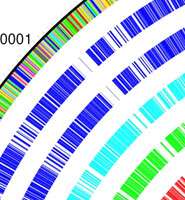Superbug genome sequenced

The genome of a newly-emerging superbug, commonly known as Steno, has just been sequenced. The results reveal an organism with a remarkable capacity for drug resistance. The research was carried out by scientists at the Wellcome Trust Sanger Institute near Cambridge and the University of Bristol.
Understanding the genome of this bacterium will help researchers discover how to deal with this particularly resistant organism. The paper will be published in Genome Biology.
Dr Matthew Avison from the University of Bristol, and senior author on the paper said: “This is the latest in an ever-increasing list of antibiotic-resistant hospital superbugs. The degree of resistance it shows is very worrying. Strains are now emerging that are resistant to all available antibiotics, and no new drugs capable of combating these ‘pan-resistant’ strains are currently in development.”
Pan-resistant Steno infections are at least as hard to treat as MRSA and C.diff infections. But although it is common in the environment, Steno infections are rarer than MRSA and C.diff infections and are exclusively hospital-acquired.
Steno flourishes in moist environments, such as around taps and shower heads, and can be transferred to patients. It is distinct in the way it causes infection and can only get into the body via devices such as catheters or ventilation tubes that are left in place for long periods of time. Long-dwelling catheters are used most often for seriously ill patients and some undergoing chemotherapy.
Steno can stick to the catheter and grow into a ‘biofilm’. When the catheter is next flushed, the Steno biofilm can enter the patient’s bloodstream. If their immune system is impaired (which is often the case in the seriously ill and those undergoing chemotherapy) the organism can multiply and cause septicaemia. The gravity of this situation has been underlined by the new research, since these patients will be treated with antibiotics against which Steno is largely resistant.
There are approximately 1,000 reports of Stenotrophomonas maltophilia (Steno) blood poisoning in the UK each year, with a mortality rate of about 30%. The organism is also found in the lungs of many adults with cystic fibrosis, and causes ventilator-associated pneumonias, particularly in elderly intensive-care patients.
The key questions that need to be addressed are: How does Steno stick to surfaces like catheters and ventilator tubes? How does it form biofilms and so survive attempts to decontaminate and clean? Why is it resistant to antibiotics?
Dr Lisa Crossman from the Sanger Institute and first author on the paper explained how the research might address these questions: “The genome sequence should help us to combat these properties. For example, if we know which proteins cause it to stick to surfaces, we could try to develop biochemical compounds that interfere with this interaction. If we understand its antibiotic resistance mechanisms, we might be able to design inhibitors that block them.”
While Steno infections are still relatively uncommon, they are on the increase. Furthermore, there are two other organisms that cause similar types of infections, but are more common.
Dr Avison added: “Genome sequences for these two also exist, and so now we can look at what they all have in common genetically that might explain why they are so resistant to antibioitics.”
Source: University of Bristol
















